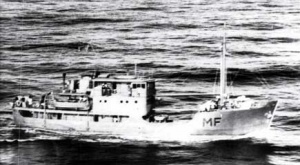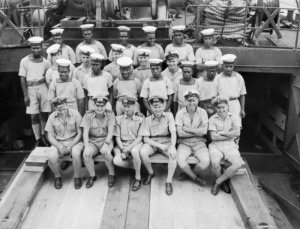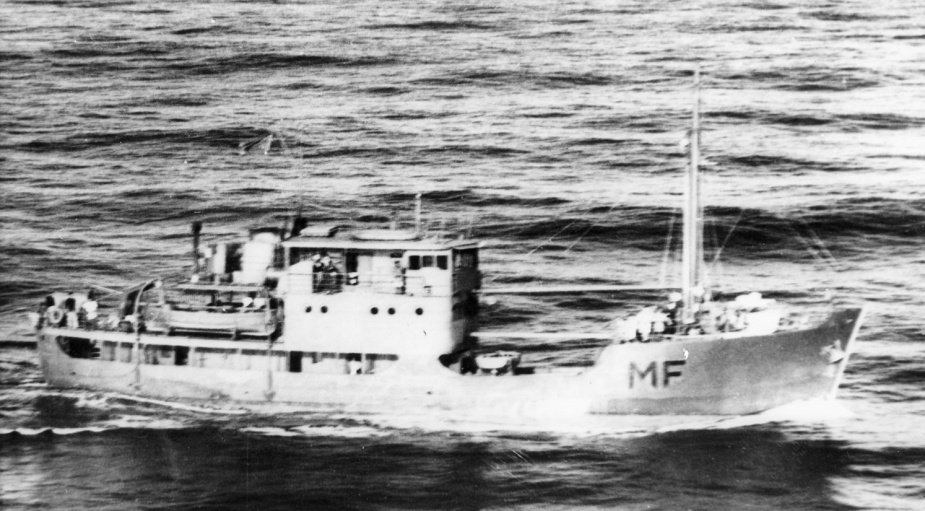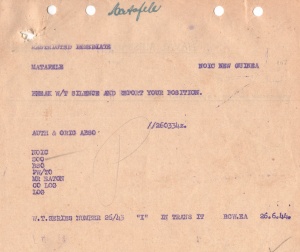HMAS Matafele
| Type |
Stores Carrier |
|---|---|
| Pennant |
MF |
| Commissioned |
1 January 1943 |
| Decommissioned |
20 June 1944 |
| Fate |
Lost without trace on 20 June 1944 |
| Dimensions & Displacement | |
| Displacement |
|
| Length | 115 feet 5 inches |
| Beam | 25 feet 6 inches |
| Awards | |
| Battle Honours | NEW GUINEA 1942-44 |
Matafele was built in Hong Kong in 1938 for Burns Philp Pty Ltd and traded on the Pacific Islands passenger-cargo routes throughout the Central Pacific (Samoa), Fiji and in the Mandated Territory of New Guinea. She carried European officers and a crew of Melanesian seaman.
In January 1942 Matafele arrived at Rabaul, the seat of administration for the Mandated Territory of New Guinea, to find the town evacuated and under air attack. Her Master decided to attempt the passage to Australia and Matafele was the last ship to steam out of Simpson Harbour as the Japanese were landing on the beaches. Fortunately she was aided by the elements, and amid heavy rain squalls she cleared St Georges Channel undetected before proceeding via Samarai and reaching the Australian mainland.
In March 1942 under the control of the Australian Commonwealth Shipping Control Board, Matafele was engaged on the east Australian coast running military stores between Cairns and Darwin. Later in 1942 she was sent to Papuan waters, operating out of Port Moresby where she was engaged in transporting stores to locations along the neighbouring coast. She was the first ship to deliver stores to Milne Bay following the Japanese landing. In December 1942 the merchant service officers were replaced by naval personnel consisting of four officers and 20 ratings. The 13 Melanesian seaman continued to make up the crew after agreeing to serve under RAN command. Matafele Commissioned at sea, becoming HMAS Matafele on 1 January 1943.
As part of the RAN, the Matafele continued to operate off the Papuan coast, transporting stores as well as supporting survey and navigation activities. She was refitted in Sydney during February-March 1944 after which she began operations as a store carrier between Queensland ports and Milne Bay. After rectifying a bearing fracture on the starboard main engine, she left Townsville for Milne Bay on 18 June 1944 under the command of Lieutenant Commander Charles Frederick Symonds, RN carrying some 215 tons of naval stores and mail for the soldiers and RAAF personnel at Milne Bay.
She had been routed via the Grafton Passage through positions 015 degrees 22 minutes south, 146 degrees 51 minutes east thence direct to Brumer Island and then through the China Strait to her destination. Her speed of advance was 7.5 knots and her estimated time of arrival at Milne Bay was 06:00K on 22 June 1944. Matafele was alleged to have been sighted by a patrolling Allied aircraft west China Strait close inshore making slow speed against heavy weather at 15:15K on 24 June 1944: but this sighting was later found to be a different vessel. On 23 June, Matafele was overdue and the Naval Officer in Command New Guinea directed her to report her position and expected time of arrival at Milne Bay; no reply was received.
On 26 June 1944 the Naval Officer in Charge New Guinea ordered Matafele to break radio silence and report her position, but again no reply was received. This triggered a wide scale search, by sea and air, off the coast of Papua and out into the Coral Sea; but no sign of her was discovered. Several weeks later some wreckage thought to be from Matafele was found off the south coast of Papua, including a boat oar with Matafele carved into the blade. None of the wreckage showed signs of damage due to enemy action. A Board of Inquiry was subsequently convened and it was presumed that HMAS Matafele foundered sometime on 20 June 1944, due to bad weather in the Coral Sea, with the loss of all hands which included four officers, 20 ratings and 13 Melanesian seamen.
The disappearance of Matafele remains a mystery, with the exact cause of her loss and the location of the wreck unknown. A memorial to perpetuate the memory of those lost in Matafele can be found in the memorial section of Point Danger Park, Tweed Heads, Queensland.









